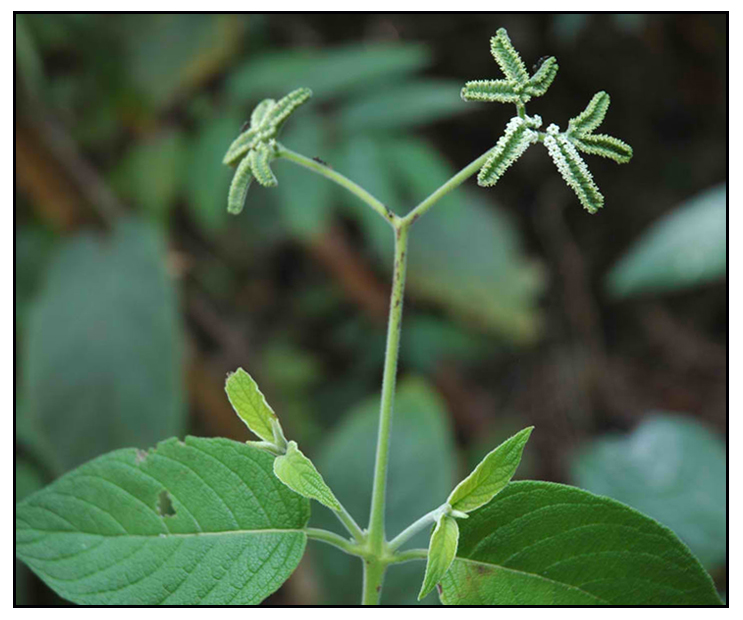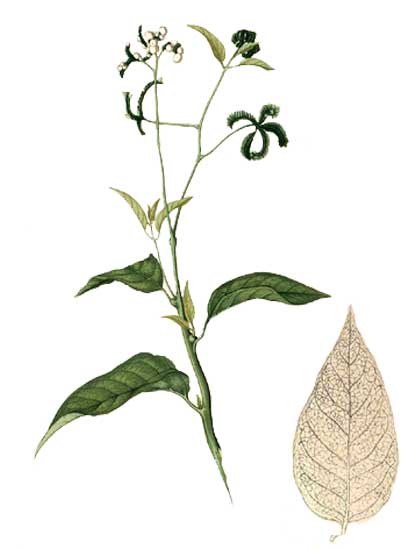 Botany Botany
Salakapo is a climbing, hairy and somewhat woody vine. Leaves are oblong, 8 to 15 centimeters long, green, shining, somewhat harsh, pointed at the tip, and usually rounded at the base. Flowers are stalkless, pale-green, 5-parted, and borne on terminal, scorpioid inflorescences (cymes) about 10 centimeters or less in diameter. Calyx is 1.5 millimeters long, and hairy. Corolla is 5 millimeters long, with a limb 3.5 millimeters in diameter. Fruit is stalkless, rounded and 4 to 5 millimeters in diameter.
Distribution
- Native to the Philippines.
-
In thickets and secondary forests at low and medium altitudes from the Babuyan Islands and northern Luzon to Palawan and Mindanao, in most or all islands and provinces.
- Also native to Andaman Is., Bangladesh, Borneo, Jawa, Laos, Lesser Sunda Is., Malaya, Maluku, New Guinea, Queensland, Solomon Is., Sulawesi, Sumatera, Taiwan, Vanuatu, Vietnam. (11)
 Constituents Constituents
- Study of stems yielded three new isoprenylbenzenes, tournefoline A, B, and C (1-2), and two new 2-ethoxy-4-5-dihydroxybenzoyl compounds, 4 and 5, together with known compounds, salicylic acid and allantoin. (1)
- Fractionation
study of stem isolated four new benzenoids, tournefolal (1), tournefolic acids A and B (2,3) and B-ethyl ester (4), together with salvianoolic acid A (5), isosalvianolic acid C (6), lithospermic acid (7), salvianolic acid F (8), and rosmarinic acid (9). (see study below) (2)
Properties
- Considered detoxicant, antioxidant, immunomodulatory, anti-inflammatory.
- Studies have suggested antioxidant, anti-lipid peroxidative, neuroprotective, hepatoprotective, neuroprotective, anti-platelet aggregation, anti-inflammatory properties.
Parts used
Roots, leaves.
Uses
Folkloric
- In the Philippines, decoction of roots given internally after childbirth, to hasten expulsion of the placenta.
- Leaves applied as poultice on the forehead for headaches.
- In Papua New Guinea,
leaves chewed by people suffering from malaria. Leaves also chewed, or mixed with food, to relieve stomachaches. (12)
- In Taiwan, used as detoxicant, anti-inflammatory, and circulation promoter to remove blood stasis. (1)
- In Trinidad and Tobago, tea leaves used as carminative. Used for cuts, injuries, and swellings. (8)
- In Chinese traditional medicine, used to reduce tissue swelling and tissue detoxification.
(13)
Others
- Livestock: Leaves used for destroying larvae in cattle ulcers. (•) In Trinidad and Tobago, leaves used for chiggers. (8)
Studies
• Anti-Lipid Peroxidative Activity / Benzenoids / Antioxidant: Study yielded four new benzenoids, tournefola, tournefolic acids A and B, and B ethyl ester, together with salvianolic acid A, isosalvionolic acid C, lithospermic acid, salvianolic acid F and rosmarinic acid from the stems of T. sarmentosa. All isolated compounds exhibited anti-LDL-peroxidative activity, more potent than probucol except for salvianolic acid F. (2)
• Neuroprotective / Polyphenolic Compounds: Study has isolated a variety of polyphenolic compounds from T. sarmentosa, most possessing antioxidative activity, including tournefolic acid B, TAB methyl ester and TAB ethyl ester. Study showed TABM / TABE blocked the activation of the caspase cascade and eliminated the accumulation of O2, thus conferring neuroprotective effects on NMDA-mediated neurotoxicity. (3)
• Hepatoprotective: Study investigated the aqueous extract effect on APAP-induced hepatotoxicity in vivo and in vitro. Pre-treatment of hepatocytes with Ts extract before and during APAP stimulation attenuated the extent of lipid peroxidation, increased cell viability and GSH level, and enhanced antioxidant enzymes. Results showed Ts can prevent APAP-induced hepatotoxicity. (5)
• Immunoregulatory: Study investigated the signaling mechanism of T. sarmentosa-medicated immunoregulation. Results suggest T. sarmentosa extract exerts dual functions on macrophages: suppressing ROS (reactive oxygen species) within cells and enhancing inflammatory responses by improving phagocytic ability and proinflammatory cytokine release. (6)
• Inhibition of ADP-Induced Platelet Aggregation / Stem: Study evaluated the effect of T. sarmentosa aqueous stem extract on adenosine diphospnate-induced platelet aggregation. Results showed the aqueous extract of stem inhibited AdP-induced platelet aggregation. Components in T. sarmentosa, including caffeic acid, rosmarinic acid, salvinolic acid played important roles in mediating adenosine diphosphate induced platelet aggregation suppression. Results demonstrate the aqueous stem extract of T. sarmentosa significantly suppressed platelet aggregation through P2Y1 and P2Y12 receptor signal pathways. The anti-aggregation properties of the stem extract might help prevent cardiovascular disease. (7)
• Enhancement of Neutrophil Phagocytosis of E. coli / Caffeic Acid: Study provides evidence that T. sarmentosa can induce increased phagocytic uptake of Escherichia coli by differentiated HL-60 cells and by neutrophils. Results suggest the aqueous extract exerts effects that enhance inflammatory responses by improving phagocytic capability, inhibiting bacterial survival within cells, and increasing Mac-1 expression of neutrophils. (9)
• Tournefolic Acid B
/ Neuroprotective on NMDA-Mediated Excitotoxicity: A variety of polyphenolic antioxidative compounds, including tournefolic acid B (TAB), have been isolated from Tournefortia sarmentosa. The TAB structure related compounds have exhibited neuroprotective potency against glutamate-mediated neurotoxicity. Study reports on the evens that eliminated the accumulation of O2 and blocked activation of the caspase cascade, thereby conferring neuroprotective effects on NMDA-mediated cytotoxicity. (10)
• Antioxidant / Inhibition of H2O2-Induced Death of H9c2 Cardiomyocytes: Study evaluated the antioxidant effect or T. sarmentosa on rat H9c2 cardiomyocytes treated with hydrogen peroxide (H2O2). T. sarmentosa reduced cell death induced by H2O2, inhibited H2O2-induced changes in cell morphology, activation of cell death-related caspases, and production of reactive oxygen species. Caffeic acid, rosmarinic acid, salvianolic acid A, and salvianolic acid B, compounds present in the extract also have similar effects in inhibiting H2O2-induced cell death. (13)
Availability
Wild-crafted.
|

![]()




 Constituents
Constituents